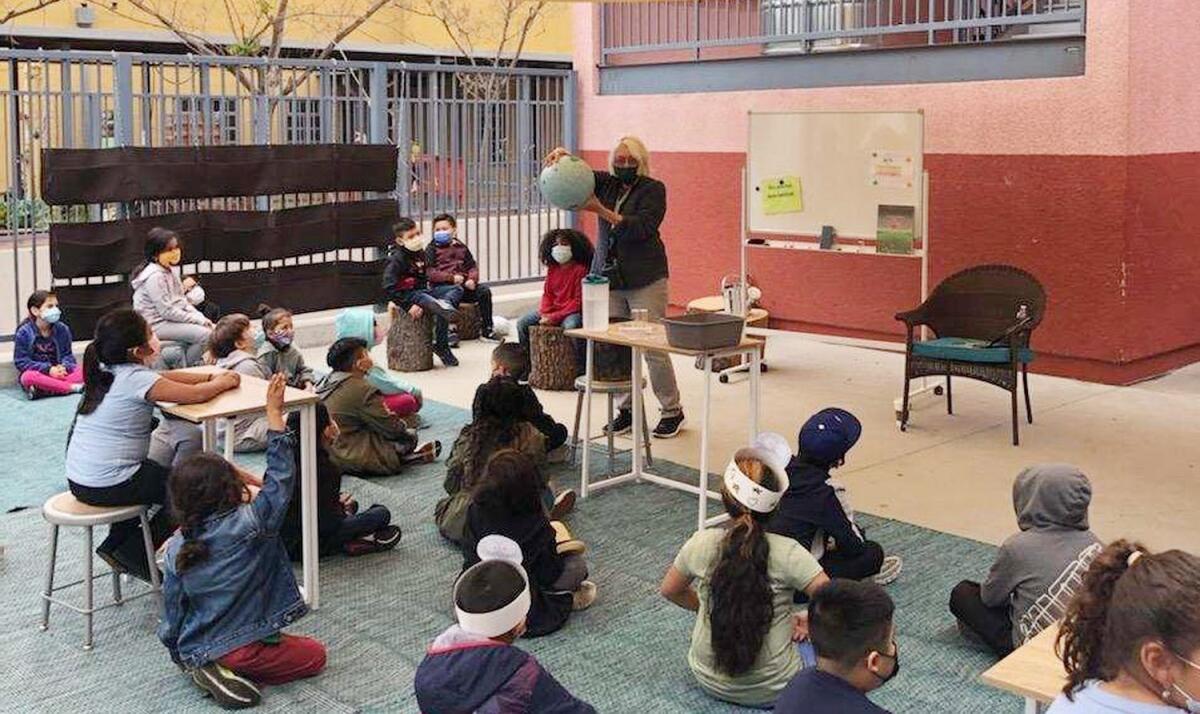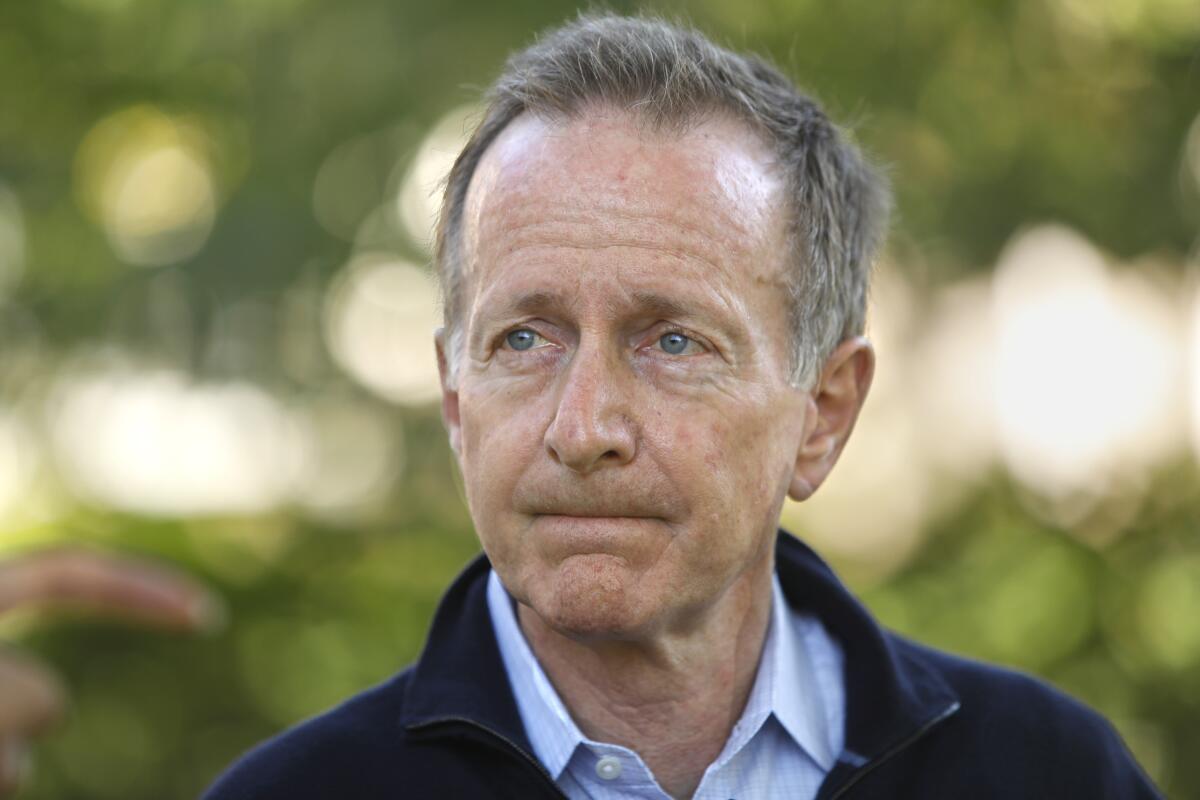8 to 3: Outdoor classrooms are rare despite COVID-19. That could soon change

This is the June 28, 2021, edition of the 8 to 3 newsletter about school, kids and parenting. Like what youâre reading? Sign up to get it in your inbox every Monday.
Hi, and welcome to the 8 to 3 newsletter. Iâm Laura Newberry, a reporter on the education team, and Iâm filling in for the vacationing Sonja Sharp.
In the summer of 2020, it was unclear when public schools in Southern California might reopen. At the same time, we were also learning more about how COVID-19 is spread.
We knew by then that we were far less likely to contract the virus outdoors. So as many of us pondered how K-12 education might resume as the pandemic raged on, there seemed to be one obvious solution: Teach kids outside.
Yet relatively few schools in California and across the U.S. moved in that direction, even though outdoor education in perpetually sunny Southern California seems like a no-brainer, and not just because of the virus. Research shows that learning outside leads to greater enjoyment of school and increased self-confidence, better attendance and academic achievement, and lower levels of stress among students.
So why isnât it more common?
To help answer this question, I spoke with Craig Strang, associate director of teaching and learning at UC Berkeleyâs Lawrence Hall of Science. Heâs also the co-founder of the National COVID-19 Outdoor Learning Initiative, an all-volunteer effort of hundreds of education experts to help schools move their classrooms outside.
California began developing a strong tradition of environmental education in the â60s, Strang explained. By the â90s, K-12 school gardens were increasingly common in cities, particularly in the Bay Area.
But that trend was cut short by the widely criticized No Child Left Behind Act of 2001, which required students to reach academic benchmarks measured by standardized testing. âWith that intense focus on reading and math scores, time outdoors started to sound like time away from school, away from learning, away from achieving consensus educational goals,â Strang said.
Meanwhile, advocates for outdoor learning â like Green Schoolyards America, which founded the National COVID-19 Outdoor Learning Initiative with Strang â never stopped espousing its benefits. When the pandemic hit, they saw an opportunity to spark a larger conversation around outdoor classrooms as school leaders across the nation searched for ways to get kids back on campus.
The initiative scrambled to create a how-to manual for building outdoor classrooms. There is a spectrum of plans, from erecting tents over asphalt at minimal cost, to entirely re-landscaping school grounds to incorporate native plants, new tree canopies and seating made from natural materials (much more expensive).
Green Schoolyards America advocated for 100% outdoor classes during the pandemic, and a handful of districts did just that. Public schools in Portland, Maine, were able to bring students back to campuses for much of the 2020-21 school year, in part, because they moved classes outside, even in the dead of New England winter. Needless to say, hand warmers and outdoor heaters were deployed.
In California, more schools than ever have begun experimenting with outdoor classrooms over the past year, though most have been private schools, thanks to having more resources than their public counterparts and fewer bureaucratic hurdles.
âCalifornia has a huge [public] school system with 6.2 million kids, strong unions and an education code you need a forklift to pick up,â Strang said. âWe got bogged down in some of those issues and that prevented large-scale implementation of innovative solutions.â
Some schools forged ahead anyway. Kingsley Elementary School in East Hollywood, with the help of a $15,000 grant from Green Schoolyards America, built four outdoor classrooms before students returned to campus in April. The spaces feature wool rugs, wicker chairs and natural-fiber cushions, umbrellas and sail shades. Plants were donated by a local nursery. A teacherâs dad, a furniture maker, contributed handmade desks.
Principal Karina Salazar led the effort. She envisioned the outdoor classrooms as part of a holistic approach to meeting the social-emotional needs of students, many of whom had not only lost the ability to interact with their peers, but also family members and financial stability, due to COVID-19.
âWe wanted to make sure they felt safe and welcome in an environment that really restored their connection to learning, sense of belonging, sense of community on campus,â Salazar said.
The vision paid off. Many parents felt more comfortable sending their kids back to Kingsley because of the minimized risk of exposure the outdoor spaces promised, even if it was for just part of the day.
Teachers signed up to use the outdoor classrooms for an hour or two at a time. Some taught regular math and science lessons, while others let students read or work independently in small groups. Salazar saw kids engage in learning in an entirely new way. They were enthusiastic, cooperative and hardly needed any redirection, she said.
Strang and others are encouraging districts to use funds from the American Rescue Plan to build outdoor classrooms, and administrators are listening. Berkeley and Oaklandâs public school districts have collectively built over 50 outdoor classrooms. And in April, L.A. Unified School District approved a resolution that calls for more resources to expand existing outdoor education programs.
Outdoor education is also an issue of equity. Children in low-income communities tend to have far less access to green spaces like city and state parks, and all the benefits that come with them.
âThose same kids were hammered by the pandemic, by the disease in their neighborhoods, by the loss of jobs,â Strang said. âWe really feel like bringing kids back to school and into outdoor spaces is one small way of leveling the playing field, and providing some healing to those most affected, most traumatized communities.â
A âonce-in-a-lifetimeâ opportunity
Youâve no doubt heard about the unexpected silver lining that the pandemic has revealed: A windfall of state revenue, coupled with unprecedented federal subsidies, has meant that schools in California suddenly have a boatload of money to spend. So how will they spend it?
L.A. Unified announced its plans this past week, and, as reported by my colleague Howard Blume, they include the hiring of 930 psychologists and psychiatric social workers, 2,190 additional teachers and 770 more custodial workers. There will be full-time nurses or nursing services in every school, and the new teachers will especially focus on math and reading in the early grades, hoping to build foundations that will carry children through successful high school careers.

âFrom crisis comes a once-in-a-lifetime chance to make things meaningfully better for the children we serve,â L.A. schools Supt. Austin Beutner said. The spending plan, he added, represents âthe values of our organization, and it places students first. Schools will have the largest increase in the number of teachers, counselors and custodians in more than a generation. All will provide services to directly benefit students.â
Also this past week, Times reporters Matt Hamilton, Brittny Mejia, Colleen Shalby and Melissa Gomez took a deeper look at the scandal at the Thacher School in Ojai, which has acknowledged a terrible history of sexual abuse and harassment allegations. Itâs not a pretty story. One dad whose daughter was an alleged victim said heâd thought Thacher was âa safe, wonderful place to put your daughter ... and then the predator strikes like a boa constrictor.â
Enjoying this newsletter?
Consider forwarding it to a friend, and support our journalism by becoming a subscriber.
Did you get this newsletter forwarded to you? Sign up here to get it in your inbox every week.
The pig in the python
Itâs what one expert calls âthe pig in the pythonâ problem. A lot of families have been unhappy with remote schooling this past year and a half, and in the case of kindergarten parents, many have yanked their children from online school with the intention of reenrolling them when in-person classes resume in the fall. One problem with that: Thereâs the potential for this fallâs kindergarten class to be substantially larger than most schools had planned for â and that bulge will follow that class for the next 12 years. Los Angeles Unified reported a 14% drop in kinder enrollment this last year â which could mean a similar-sized increase in 2021-22. âTheyâre going to have a larger class and get less personal attention,â warned Steven Barnett, co-director of the National Institute for Early Education Research. The Hechinger Report.
When kids go back to school, can they still visit grandma? Advice from the San Francisco Chronicle.
Marina PeĂąa is a success story by most standards. An immigrant from Argentina who grew up in a working-class family in L.A.âs Koreatown, sheâs a college graduate, a journalist who has covered Wall Street and now produces a podcast. But she suffers from âimposter syndrome,â she says, defined as âthe feeling that your achievements are not real or that you do not deserve praise or success.â She traces it in part to her experience at a fancy L.A. private school, where she received a full scholarship but never really felt like she belonged. âMy parents were not famous actors or screenwriters, like those of some of my wealthy schoolmates. I didnât have a nanny picking me up in a BMW after school. And my family definitely wasnât going on extended vacations to Europe during the summer.â LAist.
An initiative calling itself the L.A. Education Recovery Fund announced that it has raised nearly $10 million to help low-income students recover from the pandemic. Money goes to a panoply of youth-oriented organizations and public schools, both traditional and charter, with an emphasis on enrichment programs this summer. Roughly half the funding goes to nonprofits that assist LAUSD schools. You can find more information â or donate â here.
Thereâs something about surfing that seems to soothe autistic children, and for 25 years, Izzy and Danielle Paskowitz have helped introduce the sport to hundreds of thousands of kids with autism in California, Hawaii and the East Coast. Like so many other ventures, Surfers Healing had to pause its activities during the pandemic. But this month, it roared back in Orange County. One mom summed up the effect on her son: âTotal and complete happiness.â Orange County Register.
I want to hear from you.
Have feedback? Ideas? Questions? Story tips? Email me. And keep in touch on Twitter.
Sign up for Essential California
The most important California stories and recommendations in your inbox every morning.
You may occasionally receive promotional content from the Los Angeles Times.




